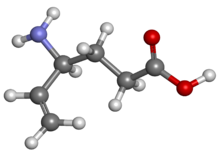Vigabatrin
Изглед
 | |
 | |
| Klinički podaci | |
|---|---|
| Prodajno ime | Sabril, Sabrilan, Sabrilex |
| Drugs.com | Monografija |
| Način primene | Oralno |
| Farmakokinetičkipodaci | |
| Poluvreme eliminacije | 7,5 ± 2,1 h |
| Izlučivanje | Renalno (80%) |
| Identifikatori | |
| CAS broj | 60643-86-9 |
| ATC kod | N03AG04(WHO) |
| PubChem | CID5665 |
| DrugBank | DB01080 |
| ChemSpider | 5463 |
| KEGG | C07500 |
| ChEMBL | CHEMBL89598 |
| Hemijski podaci | |
| Formula | C6H11NO2 |
| Molarna masa | 129,157 |
| |
| |
Vigabatrinjeorgansko jedinjenje,koje sadrži 6atomaugljenikai imamolekulsku masuod 129,157Da.[1][2][3][4][5][6][7][8][9]
Osobine
[уреди|уреди извор]| Osobina | Vrednost |
|---|---|
| Broj akceptora vodonika | 3 |
| Broj donora vodonika | 2 |
| Broj rotacionih veza | 4 |
| Particioni koeficijent[10](ALogP) | -2,4 |
| Rastvorljivost[11](logS,log(mol/L)) | -0,9 |
| Polarna površina[12](PSA,Å2) | 63,3 |
Reference
[уреди|уреди извор]- ^Gram, L.; Larsson, O. M.; Johnsen, A.; Schousboe, A. (1989).„Experimental studies of the influence of vigabatrin on the GABA system”.British Journal of Clinical Pharmacology.27(Suppl 1): 13S—17S.PMC1379673
 .PMID2757904.doi:10.1111/j.1365-2125.1989.tb03455.x.
.PMID2757904.doi:10.1111/j.1365-2125.1989.tb03455.x.
- ^Browne, T. R. (1998). „Pharmacokinetics of antiepileptic drugs”.Neurology.51(5 Suppl 4): S2—7.PMID9818917.S2CID39231047.doi:10.1212/wnl.51.5_suppl_4.s2.
- ^Lindberger, M.; Luhr, O.; Johannessen, S. I.; Larsson, S.; Tomson, T. (2003). „Serum concentrations and effects of gabapentin and vigabatrin: Observations from a dose titration study”.Therapeutic Drug Monitoring.25(4): 457—462.PMID12883229.S2CID35834401.doi:10.1097/00007691-200308000-00007.
- ^Zwanzger, P.; Baghai, T. C.; Schuele, C.; Ströhle, A.; Padberg, F.; Kathmann, N.; Schwarz, M.; Möller, H. J.; Rupprecht, R. (2001). „Vigabatrin decreases cholecystokinin-tetrapeptide (CCK-4) induced panic in healthy volunteers”.Neuropsychopharmacology: Official Publication of the American College of Neuropsychopharmacology.25(5): 699—703.PMID11682253.S2CID25547476.doi:10.1016/S0893-133X(01)00266-4.
- ^Tulloch, J. K.; Carr, R. R.; Ensom, M. H. (2012).„A systematic review of the pharmacokinetics of antiepileptic drugs in neonates with refractory seizures”.The Journal of Pediatric Pharmacology and Therapeutics: JPPT: The Official Journal of Ppag.17(1): 31—44.PMC3428186
 .PMID23118657.doi:10.5863/1551-6776-17.1.31.
.PMID23118657.doi:10.5863/1551-6776-17.1.31.
- ^Clayton, L. M.; Stern, W. M.; Newman, W. D.; Sander, J. W.; Acheson, J.; Sisodiya, S. M. (2013). „Evolution of visual field loss over ten years in individuals taking vigabatrin”.Epilepsy Research.105(3): 262—271.PMID23541931.S2CID12150292.doi:10.1016/j.eplepsyres.2013.02.014.
- ^Hawker, D. D.; Silverman, R. B. (2012).„Synthesis and evaluation of novel heteroaromatic substrates of GABA aminotransferase”.Bioorganic & Medicinal Chemistry.20(19): 5763—5773.PMC3448830
 .PMID22944334.doi:10.1016/j.bmc.2012.08.009.
.PMID22944334.doi:10.1016/j.bmc.2012.08.009.
- ^Knox C, Law V, Jewison T, Liu P, Ly S, Frolkis A, Pon A, Banco K, Mak C, Neveu V, Djoumbou Y, Eisner R, Guo AC, Wishart DS (2011).„DrugBank 3.0: a comprehensive resource for omics research on drugs”.Nucleic Acids Res.39(Database issue): D1035—41.PMC3013709
 .PMID21059682.doi:10.1093/nar/gkq1126.
.PMID21059682.doi:10.1093/nar/gkq1126.
- ^David S. Wishart; Craig Knox; An Chi Guo; Dean Cheng; Savita Shrivastava; Dan Tzur; Bijaya Gautam; Murtaza Hassanali (2008).„DrugBank: a knowledgebase for drugs, drug actions and drug targets”.Nucleic acids research.36(Database issue): D901—6.PMC2238889
 .PMID18048412.doi:10.1093/nar/gkm958.
.PMID18048412.doi:10.1093/nar/gkm958.
- ^Ghose, A.K.; Viswanadhan V.N. & Wendoloski, J.J. (1998).„Prediction of Hydrophobic (Lipophilic) Properties of Small Organic Molecules Using Fragment Methods: An Analysis of AlogP and CLogP Methods”.J. Phys. Chem. A.102:3762—3772.doi:10.1021/jp980230o.
- ^Tetko IV, Tanchuk VY, Kasheva TN, Villa AE (2001).„Estimation of Aqueous Solubility of Chemical Compounds Using E-State Indices”.Chem Inf. Comput. Sci.41:1488—1493.PMID11749573.doi:10.1021/ci000392t.
- ^Ertl P.; Rohde B.; Selzer P. (2000).„Fast calculation of molecular polar surface area as a sum of fragment based contributions and its application to the prediction of drug transport properties”.J. Med. Chem.43:3714—3717.PMID11020286.doi:10.1021/jm000942e.
Literatura
[уреди|уреди извор]- Hardman JG, Limbird LE, Gilman AG (2001).Goodman & Gilman's The Pharmacological Basis of Therapeutics(10. изд.). New York: McGraw-Hill.ISBN0071354697.doi:10.1036/0071422803.
- Thomas L. Lemke; David A. Williams, ур. (2007).Foye's Principles of Medicinal Chemistry(6. изд.). Baltimore: Lippincott Willams & Wilkins.ISBN0781768799.
Spoljašnje veze
[уреди|уреди извор]
 | Molimo Vas, obratite pažnju navažno upozorenje u vezi sa temama izoblasti medicine (zdravlja). |
